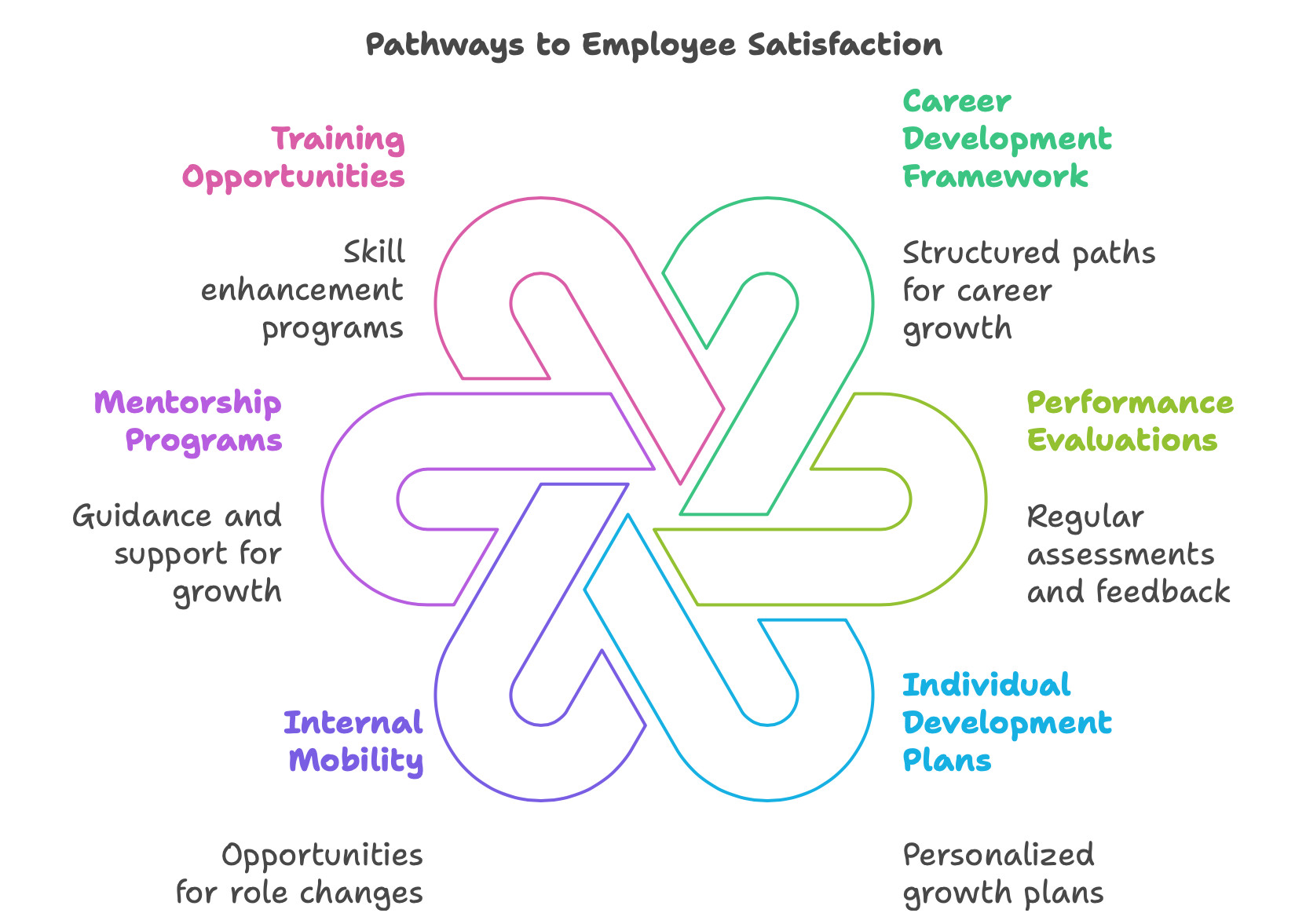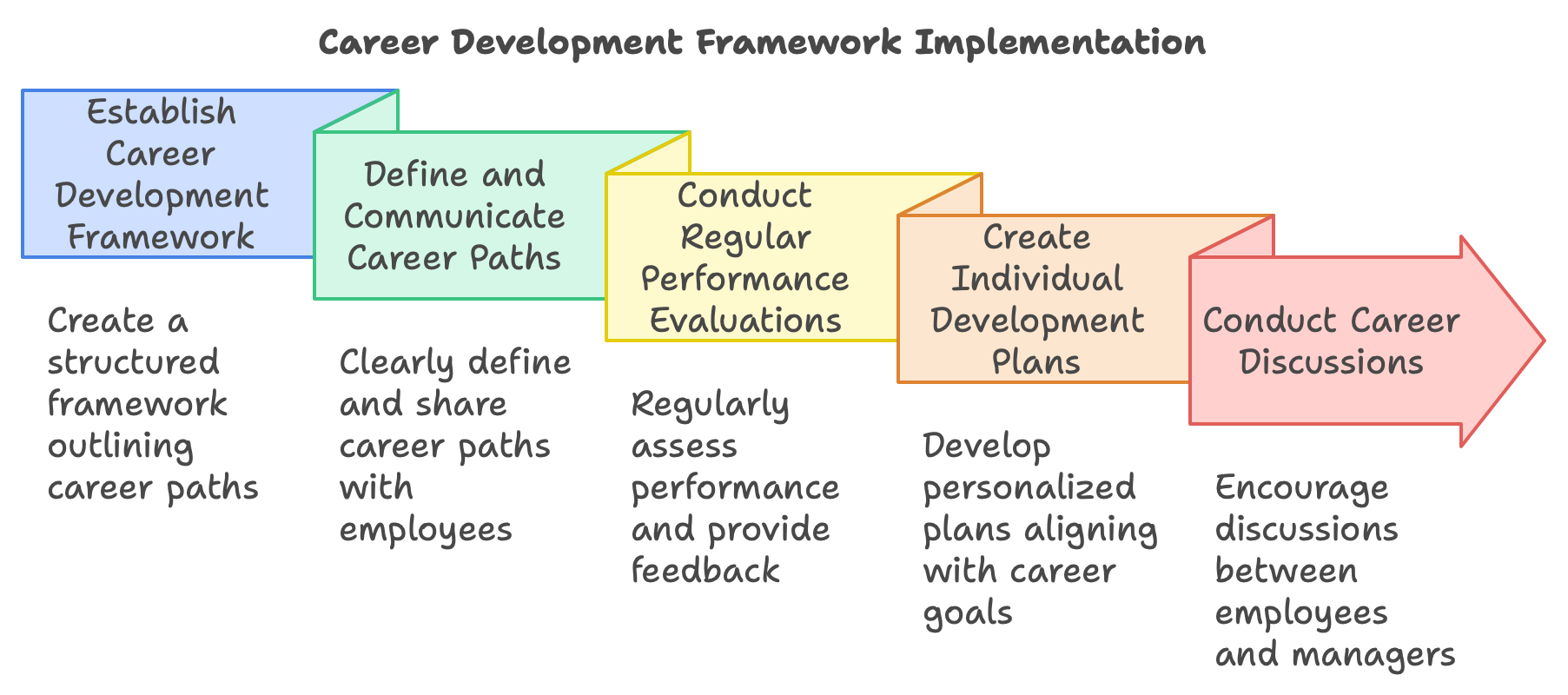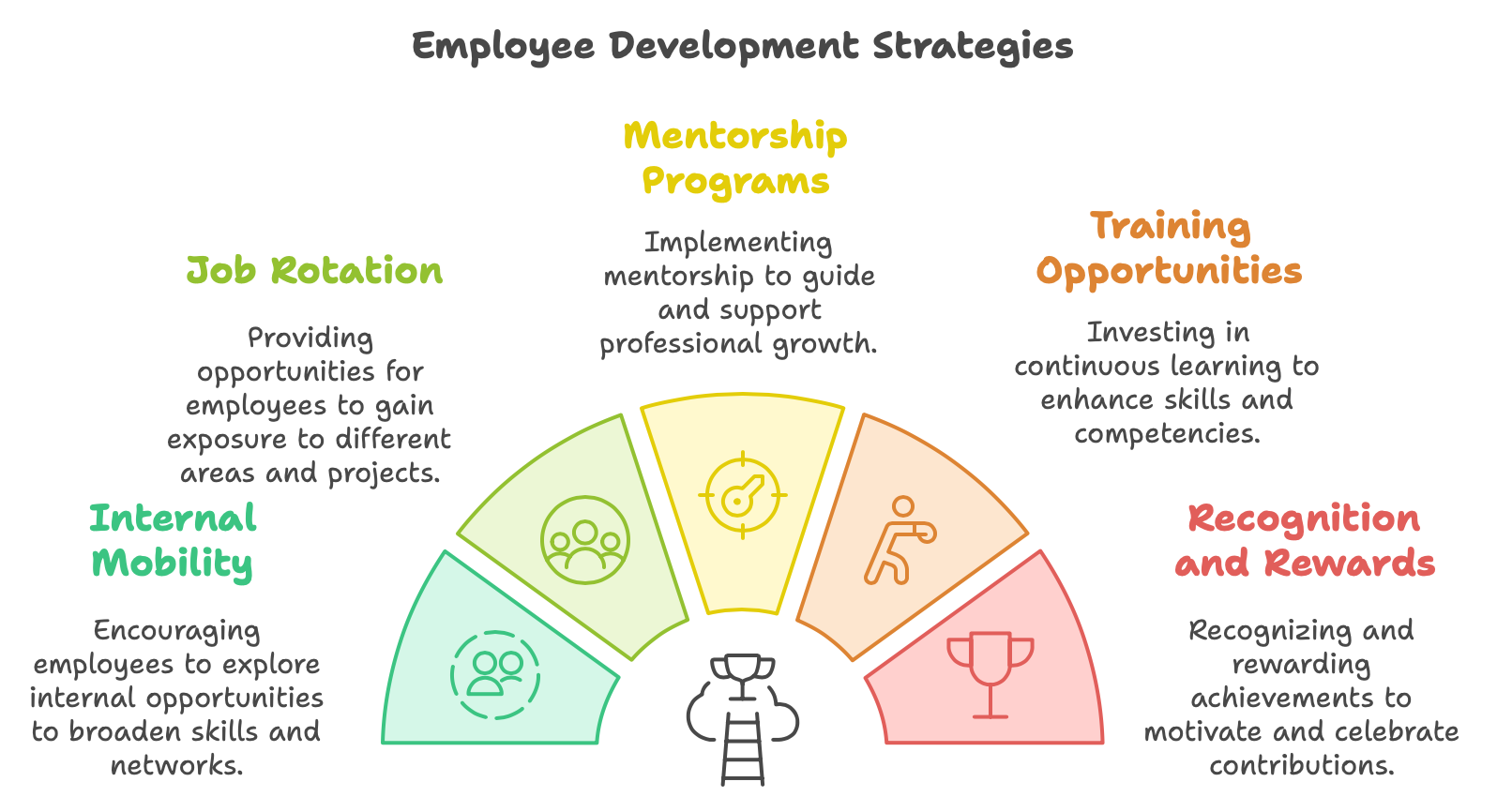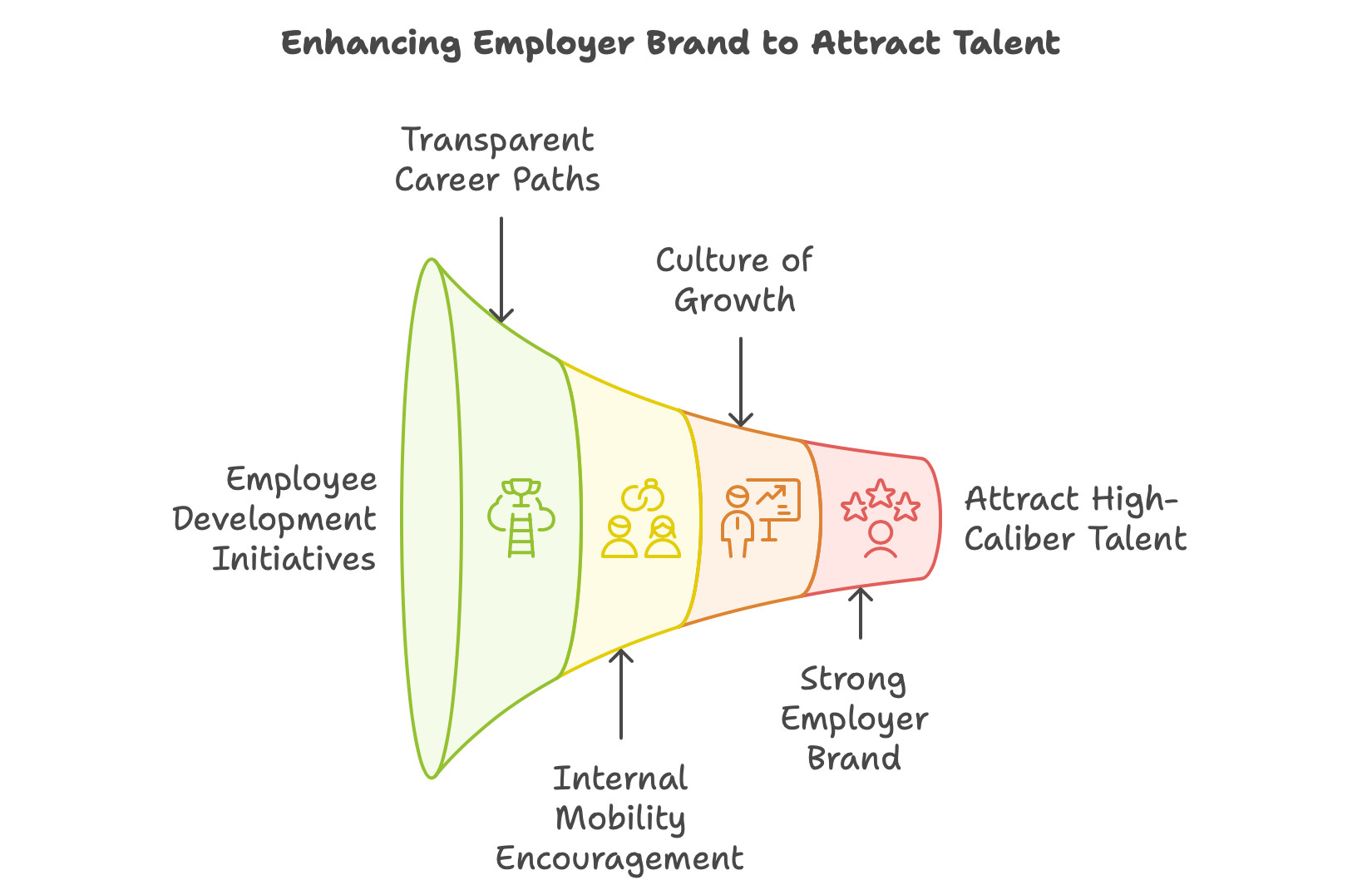The Power of Growth: Enhancing Employee Satisfaction through Clear Development Opportunities
Career pathing and growth opportunities are crucial factors in fostering employee retention and satisfaction. When employees see a clear path for their professional development and have opportunities to grow within the organization, much like People Strategy Consulting, they are more likely to stay motivated, engaged, and satisfied with their work.
They are essential for employee retention and satisfaction. They inspire motivation, foster engagement, and increase job satisfaction.
They are essential for employee retention and satisfaction. They inspire motivation, foster engagement, and increase job satisfaction.

Moreover, they contribute to the organization's success by developing a skilled and loyal workforce. By investing in employees' professional development and providing them with clear growth paths, organizations can create a positive work environment where employees feel valued and empowered to achieve their full potential.
Here are some strategies and plan to foster employee retention and satisfaction through career pathing and growth opportunities:
Creating Clear Career Pathways to Drive Employee Growth and Development
Establish a clear career development framework: Create a structured framework that outlines various career paths within the organization, much like the approach taken in HRIS Implementation. This framework should include different levels, roles, and responsibilities, as well as the skills and competencies required for advancement. Communicate this framework to employees and ensure it is easily accessible and understood.
Define and communicate career paths: Clearly define different career paths within the organization, including the various levels, roles, and responsibilities. This should cover both vertical and lateral moves. Develop job descriptions and competency models for each role to provide clarity on the skills and qualifications required for advancement. Ensure that employees are aware of the available career paths and the opportunities for growth within the organization. Share this information through internal communications channels, such as company intranet, newsletters, and town hall meetings. Hold regular discussions with employees to explain the different career paths and answer their questions.
Define and communicate career paths: Clearly define different career paths within the organization, including the various levels, roles, and responsibilities. This should cover both vertical and lateral moves. Develop job descriptions and competency models for each role to provide clarity on the skills and qualifications required for advancement. Ensure that employees are aware of the available career paths and the opportunities for growth within the organization. Share this information through internal communications channels, such as company intranet, newsletters, and town hall meetings. Hold regular discussions with employees to explain the different career paths and answer their questions.

Conduct regular performance evaluations: Regularly assess employee performance and provide feedback on their strengths and areas for improvement. Performance evaluations, akin to Performance Management Services offered by UnitiQ, can serve as a platform to discuss career goals and aspirations. Encourage employees to actively participate in these discussions and provide input on their own development plans.
Individual development plans: Work with employees to create individual development plans (IDPs) that align with their career aspirations and the organization's needs. IDPs should outline specific goals, learning objectives, and actions needed to achieve them. Provide resources, training, and mentoring opportunities to support employees in their development journey.
Conduct career discussions: Encourage employees to have regular career discussions with their managers. These discussions should focus on understanding their career aspirations, strengths, and areas for development. Managers can then provide guidance on potential career paths and the steps needed to progress. Emphasize the importance of two-way communication, where employees can express their goals and managers can provide realistic expectations.
Empowering Growth Through Internal Mobility, Mentorship, and Development Opportunities
Promote internal mobility: Actively promote internal mobility by encouraging employees to explore opportunities within the organization. Make job postings and promotion opportunities visible and accessible. Internal job rotations and transfers can broaden employees' skill sets, expand their network, and keep them engaged and motivated.
Job rotation and cross-functional projects: Provide employees with opportunities for job rotation and cross-functional projects. This allows them to gain exposure to different areas of the organization, broaden their skill set, and build a diverse network. Encourage employees to take on stretch assignments and challenging projects that will help them develop new skills and demonstrate their capabilities.
Mentorship and coaching programs: Implement mentorship and coaching programs to support employees' professional growth. Assign experienced mentors who can provide guidance, share knowledge, and offer career advice. Regular coaching sessions can help employees navigate challenges, set goals, and stay on track.
Job rotation and cross-functional projects: Provide employees with opportunities for job rotation and cross-functional projects. This allows them to gain exposure to different areas of the organization, broaden their skill set, and build a diverse network. Encourage employees to take on stretch assignments and challenging projects that will help them develop new skills and demonstrate their capabilities.
Mentorship and coaching programs: Implement mentorship and coaching programs to support employees' professional growth. Assign experienced mentors who can provide guidance, share knowledge, and offer career advice. Regular coaching sessions can help employees navigate challenges, set goals, and stay on track.

Training and development opportunities: Invest in continuous learning and development programs to enhance employees' skills and competencies. Offer a range of training options, such as workshops, seminars, online courses, and conferences. Support employees in obtaining certifications or advanced degrees that are relevant to their roles and career goals.
Recognition and rewards: Recognize and reward employees for their achievements and contributions. Link career progression and growth opportunities with performance-based rewards, such as promotions, salary increases, and bonuses. Celebrate milestones and accomplishments to reinforce the value of employee development.
Transparent communication: Foster open and transparent communication about career paths, growth opportunities, and organizational changes. Keep employees informed about new positions, projects, and initiatives. Regularly communicate the progress of the organization and how it aligns with employees' career goals.
Regular check-ins and feedback: Maintain open lines of communication with employees through regular check-ins and feedback sessions. Listen to their concerns, provide constructive feedback, and address any issues that may hinder their career growth. Regularly revisit employees' career goals and adjust plans accordingly.
By implementing these strategies, organizations can create a positive and engaging work environment that fosters employee retention and satisfaction. When employees see a clear path for growth and have opportunities to develop their skills, they are more likely to stay committed and contribute to the organization's success.
Strengthening Talent Acquisition Through Employer Branding and Growth Opportunities
By implementing a transparent career path framework, encouraging internal mobility, and fostering a culture of growth, I’m not just creating opportunities for current employees but also making my company more appealing to high-caliber talent.
As a business, I know that attracting top-tier candidates goes beyond just offering competitive salaries. It’s about building a strong employer brand and having a clear, structured approach to talent acquisition.

When candidates see that we invest in employee development, offer mentorship programs, and provide clear pathways for career advancement, they’re more likely to view us as a forward-thinking employer.
This kind of employer branding sets us apart in a competitive market and enhances our ability to attract and retain the best talent. It shows that we’re not just filling roles; we’re committed to helping individuals grow and succeed within our organization.
Read related articles:
How Growing and Scaling Businesses Can Attract Top Talent: Proven HR Strategies for Success
Unlocking Talent Acquisition and HR Excellence with UnitiQ
UnitiQ provides businesses with on-demand HR expertise, offering tailored support in key areas like talent acquisition, HR operations, and overall people strategy.
Whether a company needs assistance with hiring top talent, managing day-to-day HR tasks, or crafting long-term plans for employee growth, UnitiQ delivers flexible solutions. They focus on finding candidates who align with a company’s values and culture, ensuring hires not only have the right skills but also fit seamlessly into the team.
Read related articles:
Stop Waiting, Start Hiring: How Active Talent Acquisition Drives Business Growth
Smart Hiring: A Step-by-Step Guide to Avoiding Costly Recruitment Mistakes
Why Startups Need Fractional HR: Immediate Expertise at a Fraction of the Cost
Their industry-specific experts help streamline the hiring process, from job design to interviewing, all while maintaining compliance with HR regulations.
By providing access to top HR professionals without the overhead of a full-time hire, UnitiQ helps businesses scale and thrive efficiently.
Whether a company needs assistance with hiring top talent, managing day-to-day HR tasks, or crafting long-term plans for employee growth, UnitiQ delivers flexible solutions. They focus on finding candidates who align with a company’s values and culture, ensuring hires not only have the right skills but also fit seamlessly into the team.
Read related articles:
Stop Waiting, Start Hiring: How Active Talent Acquisition Drives Business Growth
Smart Hiring: A Step-by-Step Guide to Avoiding Costly Recruitment Mistakes
Why Startups Need Fractional HR: Immediate Expertise at a Fraction of the Cost
Their industry-specific experts help streamline the hiring process, from job design to interviewing, all while maintaining compliance with HR regulations.
By providing access to top HR professionals without the overhead of a full-time hire, UnitiQ helps businesses scale and thrive efficiently.
